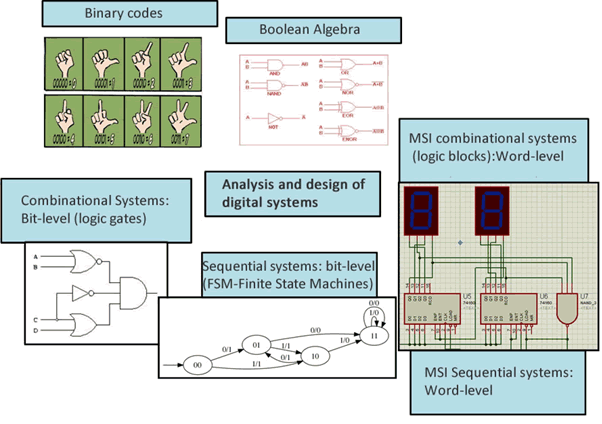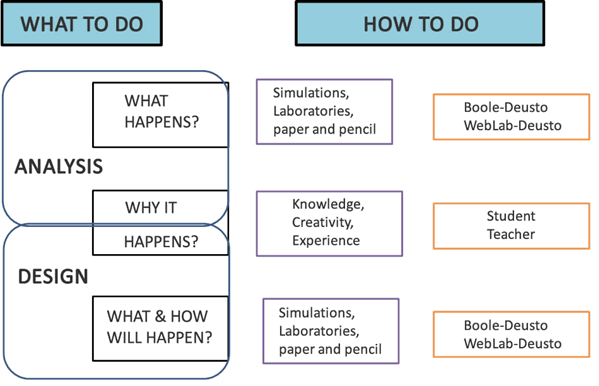“Logic Gates” Module Development Scenario: Digital Electronics
Electronics in general and digital electronics in particular, are one of the current technological engines. After all, a computer is nothing else that a complex digital system.
Despite being a complex system, a computer is, from a digital standpoint, composed of two possible values 0 and 1 and three types of logic gates (logic operators): AND, OR and NOT. This module is focused on the principles of those bits and logic operators.
In digital electronics, like in other areas, the main task consists on the analysis and design of systems, digital ones in this case. The peculiarity for a student is that digital electronics is based on information (bits) and algebra (Boole) completely new. Thus, before we learn to analyse and design systems, it is necessary to learn how to represent (binary codes) and manipulate (Boolean Algebra) digital binary information. The following figure shows three core parts of digital electronics: binary codes, Boolean Algebra and the analysis and design of digital systems.

Digital circuits are classified in the following four groups: combinational or sequential, bit- or word-level. In this module we will be only working with bit-level combinational systems (logic gates) since they are the most basic conceptually and besides are the most suitable from a methodological standpoint.
Before we start, it is convenient to remember that the basic design mechanism is a cycle: proposed circuit design (hypothesis), proposed circuit analysis (evaluation against requirements) and re-elaboration of the proposed design (taking into account the analysis results).

The module development is divided in two parts. In first place, the binary representation of the information is tackled (binary codes) and their mathematical manipulation (Boolean Algebra) and in second place, the bit-level combinational digital system analysis and design is carried out, i.e. the analysis and design of digital circuits based on logic gates (bit-level).
For that, we will work with two tools: Boole-Deusto and Weblab-Deusto. Boole-Deusto is an application that allows the student to analyse and design, step-by-step, of bit-level digital systems, and to the teacher the analysis and design, step-by-step, of bit-level digital systems, including the capture, minimization and drawing of digital circuits.
WebLab-Deusto is a remote laboratory that allows the student to complete digital electronics real experiments without having to have access to a real laboratory. The access and control of the experiment is performed through Internet, anywhere and at any time. Thus, the student and the teacher can analyse and design real digital systems without economic and organizational effort, both in the class and at home.